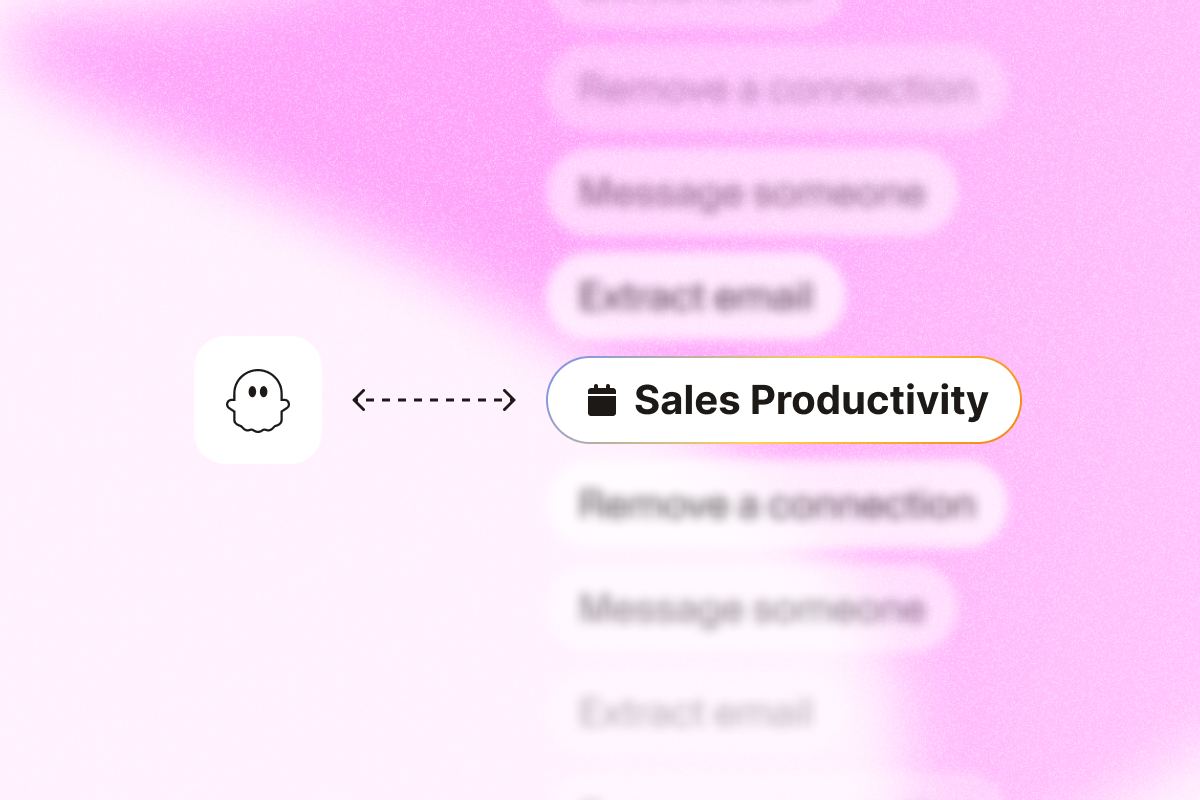Sales productivity means giving your sales team the right tools and resources to close deals efficiently.
When sales professionals have access to essential data, streamlined workflows, and clear insights, they connect better with leads and turn prospects into loyal customers.
This guide dives into strategies and tools that improve sales activities, such as lead generation, and boost sales productivity.
TL;DR
- Sales productivity focuses on maximizing outcomes from resources like time, money, and energy by balancing efficient resource use and effective results.
- Strong sales productivity lets reps close deals faster, bring in more revenue, lower costs, improve customer satisfaction, and stay motivated by concentrating on high-impact leads and actions.
- Tracking key sales productivity metrics, like conversion rate and average deal size, gives a clear view of sales team performance, highlights areas for improvement, and helps focus on activities that drive revenue.
- Here are some actionable steps to enhance sales productivity:
- Use intent data for prospecting: Target leads who already show interest in your industry to focus on high-potential contacts.
- Enrich your leads list automatically: Gather LinkedIn data on each lead to create more tailored, relevant outreach.
- Implement lead scoring: Prioritize high-quality leads by scoring them based on engagement and key attributes.
- Craft personalized messages with AI: Use AI to create messages that feel personal, helping you connect better with potential clients.
- Keep your sales pipeline clean: Automate CRM updates to focus on active, high-value leads without manual data entry.
- Align your sales and marketing teams: Having clear lead qualification and lead scoring processes and regular syncs helps both teams achieve shared goals.
- Optimize your sales onboarding: Fast-track new reps with a clear, structured onboarding process for quicker results.
- Provide ongoing sales training: Regular training keeps your team sharp and updated on sales techniques.
- Encourage continuous learning: Foster a learning culture to keep reps adaptable and prepared for changes.
- Measure sales productivity regularly: Track key metrics to stay informed on what’s working and adjust as needed.
- PhantomBuster is a powerful tool for boosting sales productivity. It automates lead generation, contact data enrichment, and LinkedIn outreach.
What is sales productivity?
Sales productivity means getting the best results from the resources you use, such as time, money, and energy.
It means balancing sales efficiency—using resources smartly—and sales effectiveness, which is about closing deals and achieving the right results.
When sales managers maximize productivity, they make the most of every hour and dollar.
Instead of working harder, they focus on working smarter, directing their efforts toward the actions and leads most likely to turn into revenue.
Why is sales productivity important for sales reps?
Sales productivity drives better results with fewer resources, impacting both individual reps and the sales team.
Here’s why it matters:
- Faster deal cycles: Reps close deals faster when focusing on high-quality leads and effective actions.
- Higher revenue: Sales reps who do better bring in more revenue, so the team gets more money without adding staff or resources.
- Lower costs: Focusing efforts on the biggest impact reduces wasted resources.
- Improved customer satisfaction: Concentrating on the right leads means more personalized and meaningful interactions, which leaves customers feeling valued.
- Increased team morale: Reps feel more motivated and engaged when they see results.
Key sales productivity metrics your sales team should track
Tracking the right sales metrics keeps your sales leaders focused on what really drives results.
These metrics give you a solid view of how your sales team is performing, where you might need to adjust, and which activities lead to more closed deals.
Here’s a concise breakdown of key sales productivity metrics your sales team should track.
Number of leads created
This one’s simple: It’s how many new leads enter your sales pipeline over a set period.
A steady flow of new leads keeps your pipeline healthy and helps ensure future sales. If this number dips, it could signal a need to ramp up outreach.
This one’s easy to measure:
Count of new leads in a given period
Number of completed sales activities
This metric tracks all the calls, emails, and meetings your sales team completes.
It shows how actively they’re working to connect with potential customers. More activity often means more opportunities, which can lead to better results.
Here’s a simple way to keep track:
Total completed activities per rep
Conversion rate
Conversion rate tells you how many leads become actual customers.
High conversion rates mean your team is good at moving people from interest to decision. A low conversion rate might mean it’s time to review your sales approach.
To calculate it, use this formula:
(Number of closed deals / Number of leads) x 100
Win rate
Win rate is the percentage of deals closed out of all proposals sent.
This metric shows how effective your team is at sealing the deal.
A high win rate means strong negotiation skills and a good match between your solution and your target leads.
Here’s how to estimate it:
(Closed deals / Total proposals) x 100
Average deal size
The average deal size tells you the typical revenue from each closed deal.
Knowing this helps you forecast revenue and focus on deals with the most potential impact. Bigger deal sizes mean bigger wins.
Here’s the formula:
Total revenue from deals / Number of deals
Sales cycle length
This metric tracks how long it takes, on average, to close a deal—from first contact to final signature.
A shorter sales cycle means quicker revenue and greater efficiency, while a long cycle might suggest a need to streamline the sales processes.
Here’s how to measure it:
Total time to close deals / Number of deals
Average revenue per customer
This shows the average revenue each customer brings in.
It helps you understand customer value and can highlight opportunities for upselling and cross-selling.
A higher average revenue per customer boosts profitability.
To calculate it, use this formula:
Total revenue / Total number of customers
How to enhance sales productivity to streamline your sales process
Boosting sales productivity comes down to ensuring your team has the right tools and resources to close deals faster and more effectively.
That’s where sales enablement makes a difference.
When reps have everything they need—whether it’s data, insights, or efficient workflows—they engage with prospects better, move deals along faster, and drive higher revenue.
Here’s how to boost your sales productivity.
Use intent data for prospecting and grow your sales pipeline effectively
With intent data, you know which leads are already engaged in your industry so that you can prioritize your outreach.
Gathering contacts from relevant events or from the comment section on an influencer’s post in your niche helps your team reach people who are already interested.
You can use LinkedIn automation tools, such as the LinkedIn Event Guests Export, to pull attendee lists from LinkedIn events related to your industry.
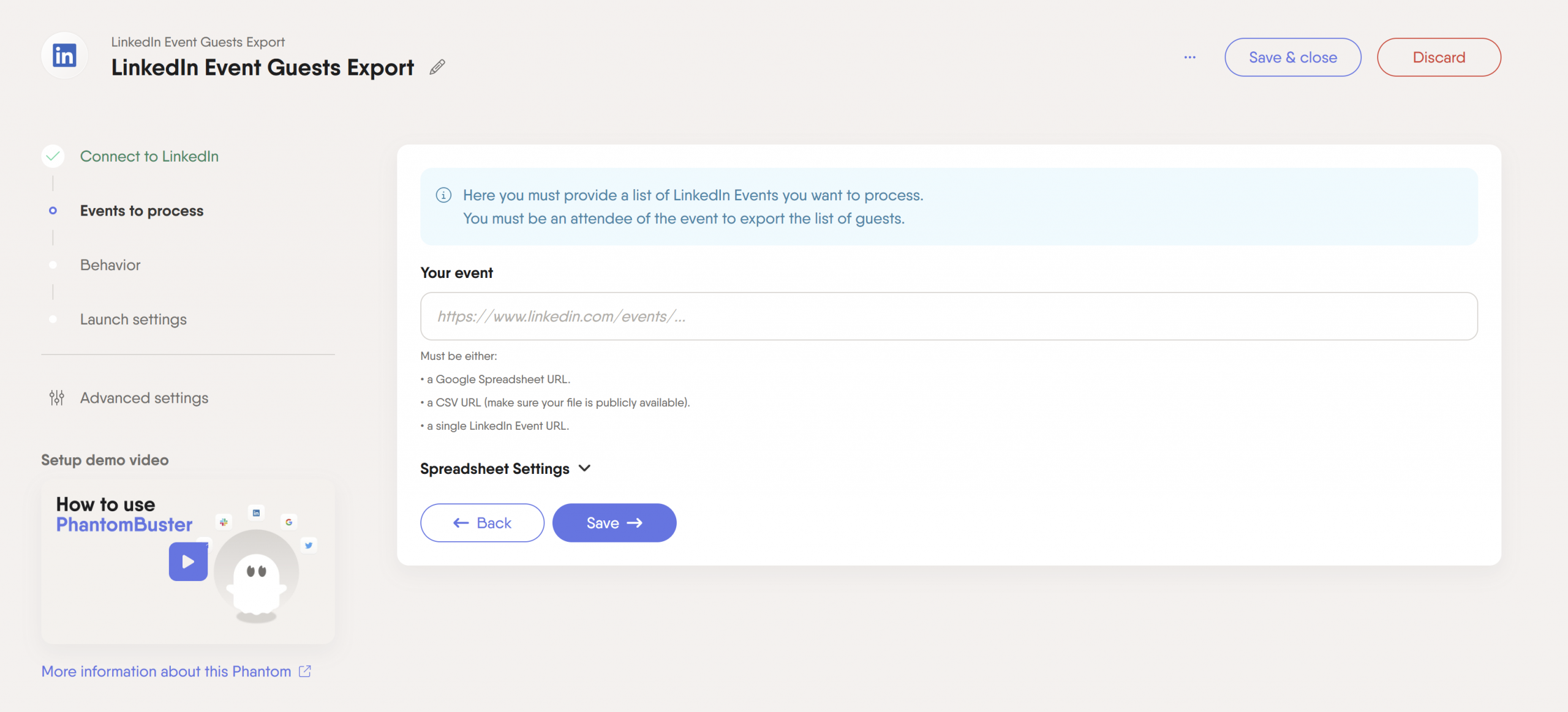
This means you’re not starting from scratch—you’re targeting people who already care about topics in your field.
It’s a smarter, more efficient way to build your sales pipeline with leads that have real potential.
Get high-value information by automatically enriching your leads list
Knowing your leads inside out makes all the difference in sales. With the right contact data, you don’t just reach out—you connect in a way that feels relevant to them.
If you’re considering scraping LinkedIn data, we recommend using the LinkedIn Profile Scraper.
It makes it easy to scrape all the available data from LinkedIn profiles, including verified professional email addresses.
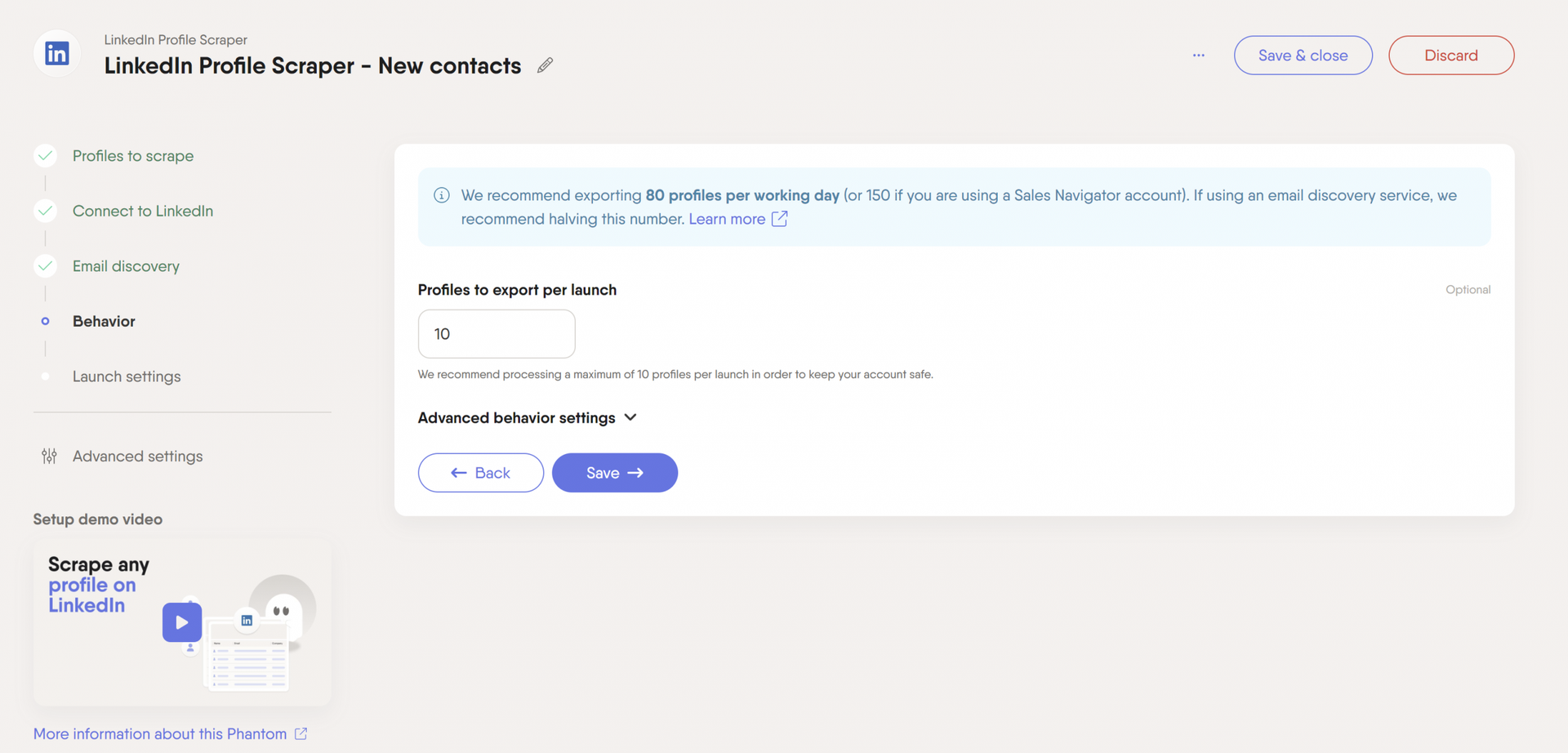
Plus, you save even more time when you connect your HubSpot CRM to the LinkedIn Profile Scraper.
It’ll automatically enrich your contacts with the latest LinkedIn info and track profile changes to keep your list updated.
Implement lead scoring to prioritize high-quality leads
Using lead scoring, you can assign a numerical value to each lead based on their actions and attributes, like visiting your pricing page or having a high-level job title.
This score helps you prioritize qualifying leads based on how ready they seem to buy.
When it comes to implementing lead scoring, PhantomBuster’s AI LinkedIn Profile Enricher can help you use AI to dig into key details—like whether someone has decision-making power based on their job position or specific interests relevant to your product.
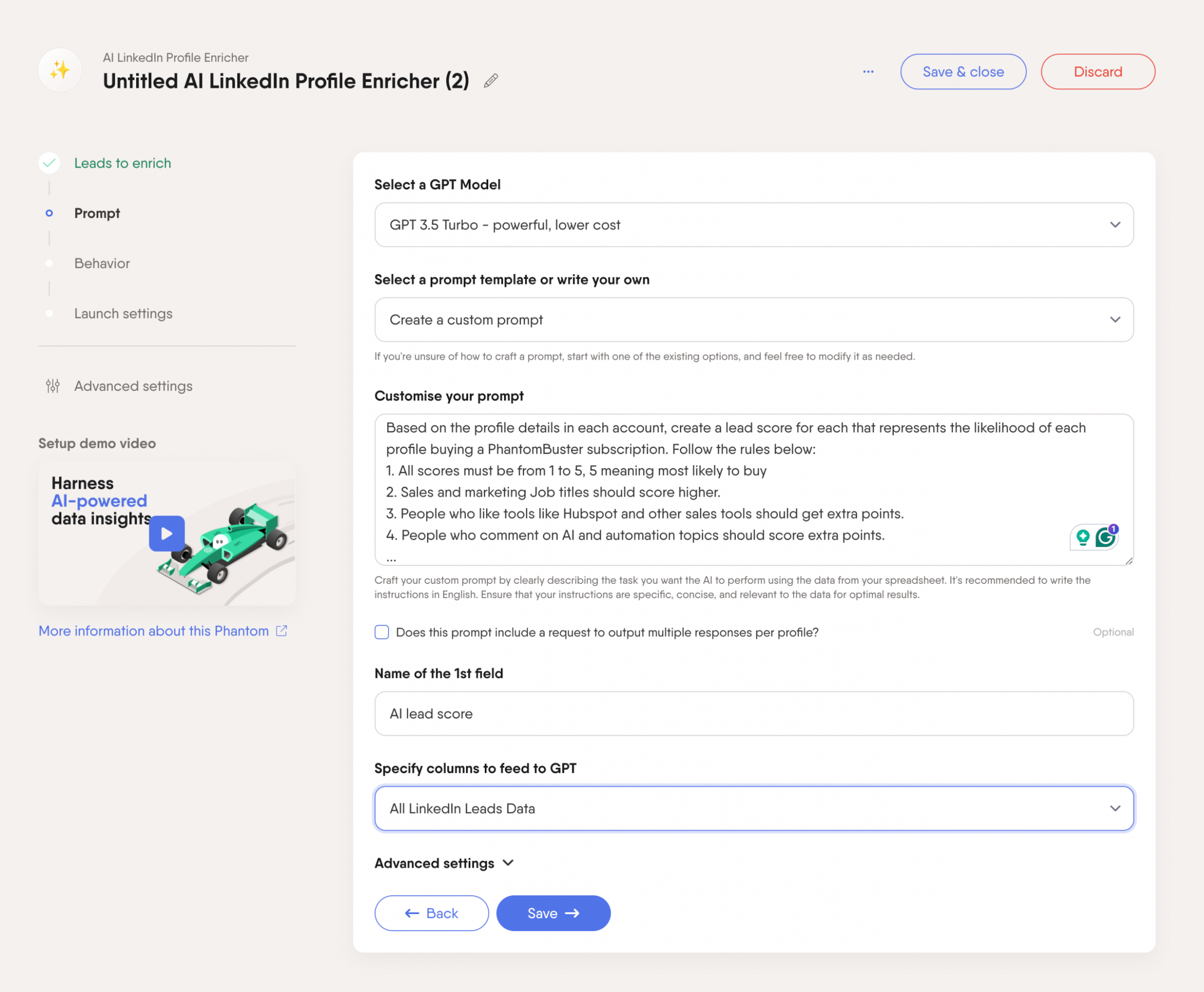
You get richer insights that make lead scoring more accurate and meaningful.
Plus, you can customize the scoring criteria to fit your team’s needs.
This means you’re working with a refined list of potential buyers, each one scored and ranked, so you’re always putting your energy into the right opportunities.
Use AI to craft personalized messages for better sales outreach
AI can help you can build stronger relationships with less manual effort.
When your outreach feels tailored and relevant, prospects are more likely to engage. So your team can focus on finding high-quality leads while AI handles the personalization.
With PhantomBuster’s AI LinkedIn Message Writer, you can move beyond generic connection requests and reach each lead with a message that speaks directly to them.
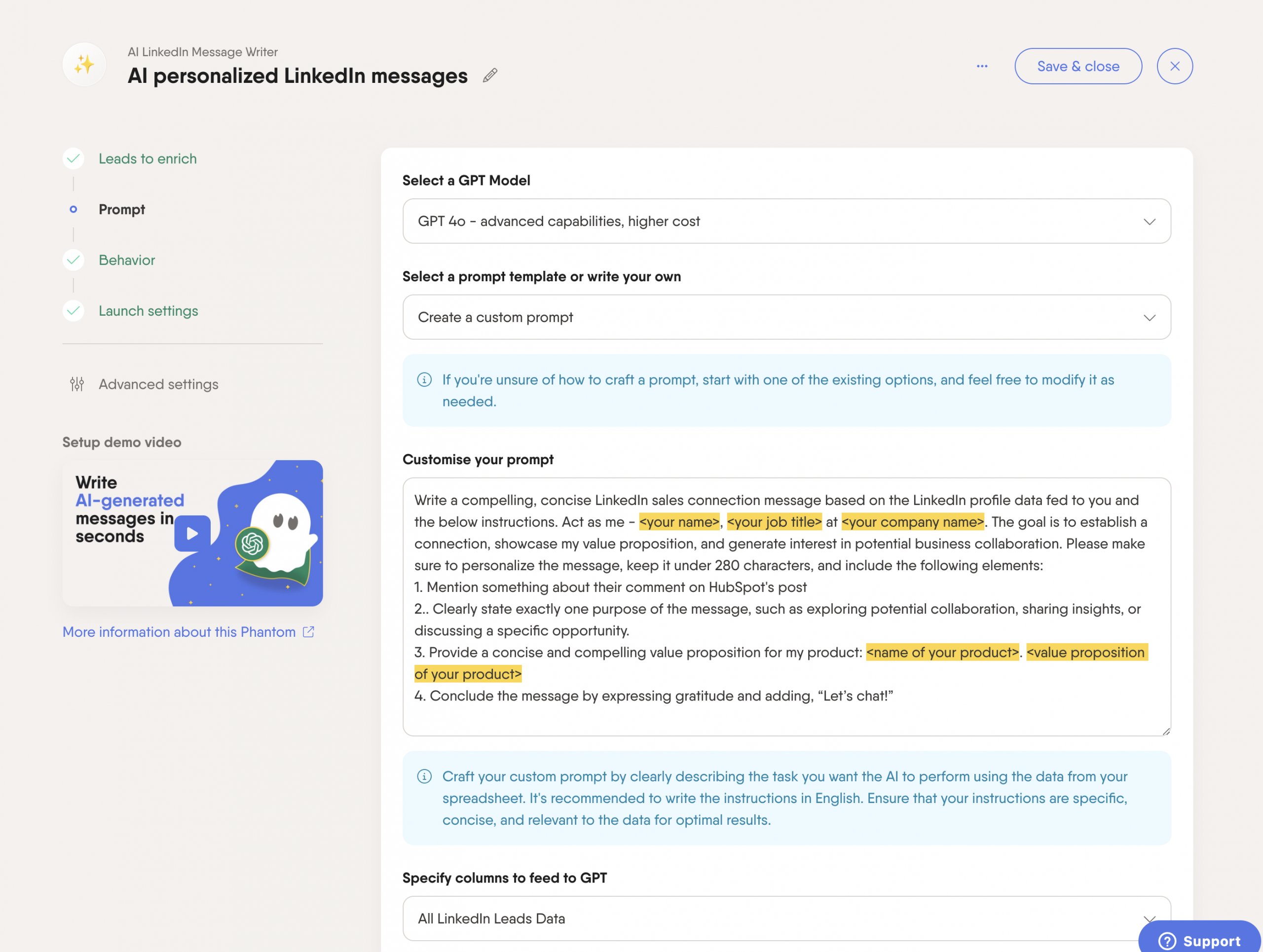
This tool helps you create unique, relevant messages for every prospect on your list.
Instead of sounding like a mass message, each outreach feels customized — mentioning things like their job title, company, or recent interactions with posts on LinkedIn.
These details make a huge difference, especially when you’re trying to build meaningful connections with minimal effort.
Keep your sales pipeline clean
A tidy sales pipeline keeps things running smoothly.
When you automate tasks like CRM data enrichment, your lead data stays fresh, so you’re not wasting time on outdated info. This means you can focus on the leads that matter.
With PhantomBuster’s HubSpot Contact Sender, you can send fresh leads from LinkedIn straight into your HubSpot CRM without lifting a finger.

Your contacts stay current, so you don’t waste your time on stale prospects.
Align your sales and marketing teams
When marketing and sales teams work together, there are smoother handoffs and fewer mixed messages. Marketing attracts leads; sales turns them into customers.
To make this seamless, both teams need a clear view of target audiences, messaging, and goals.
Set up a clear process for lead qualification and lead scoring, and then schedule regular syncs to discuss what’s working and refine your shared approach.
This saves time and keeps everyone focused on high-potential leads.
Optimize your sales onboarding process
A solid onboarding process helps new reps hit the ground running. Make sure they know the product, your CRM, and the sales process inside and out.
Consider a structured plan with training, shadowing, and check-ins to set clear expectations and boost confidence. The faster they ramp up, the sooner they contribute to your team’s success.
Provide your team with sales training
Consistent training keeps sales teams sharp and confident. It refines their skills, introduces new techniques, and keeps them up-to-date with product changes.
Whether through workshops, courses, or coaching, investing in training builds a more capable team.
This leads to better performance and closing more deals.
Encourage continuous learning for your sales reps
Sales are constantly changing, so it’s smart to keep learning. Encourage sales reps to stay curious, whether through webinars, articles, or certifications.
Supporting ongoing learning shows your team that growth matters. This keeps them engaged, adaptable, and ready to tackle challenges head-on.
Keep measuring sales productivity regularly
Regularly tracking productivity metrics, like conversion rates and deal size, gives you a clear picture of what’s working.
Review these metrics as a team to spot trends, make adjustments, and stay aligned with goals. When sales productivity is a measurable goal, improvement becomes an achievable process.
4 Best tools for sales teams to increase sales productivity
Having the right tools in place is essential to increase your team’s productivity.
From CRM platforms and lead generation software to sales engagement tools and meeting schedulers, each tool plays a specific role in streamlining workflows and maximizing efficiency.
Here’s a roundup of top tools that can simplify your sales process.
PhantomBuster
PhantomBuster is a powerful tool for boosting sales productivity, especially when it comes to automating the repetitive, time-consuming parts of the sales process.
It takes care of tasks like lead generation, data enrichment, and workflow automation so your team can focus more on building relationships and closing deals.
With its flexible, scalable setup and easy integration options, PhantomBuster is a great choice for small—to medium-sized businesses that want to streamline their sales operations with less manual effort.
Here are some of the top features and benefits to improve sales productivity:
- Intent-based lead generation that helps you connect with prospects who are already showing interest in what you offer, so you’re reaching out to warmer leads.
- AI-powered lead enrichment that finds and verifies contact information, and adds relevant details to your leads list.
- HubSpot bi-directional integration for seamless contact management and workflow automation, making it easy to keep your CRM updated and organized.
- 100+ pre-built automations that handle tasks on platforms like LinkedIn, Twitter, and Sales Navigator, taking care of repetitive work so your team doesn’t have to.
- 24/7 automation that keeps running without manual intervention, ensuring your pipeline grows steadily—even when you’re not actively monitoring it.
Pricing
PhantomBuster’s pricing starts at $56/month after a 14-day free trial, including 20 hours of execution time, 5 Phantom slots, and 10,000 AI credits. More advanced plans are available for larger projects.
HubSpot
HubSpot brings all your customer management, marketing, and sales tools together in one place.
It’s designed to improve sales productivity by streamlining your workflow, reducing tool switching, and keeping your team focused on building relationships and closing deals.
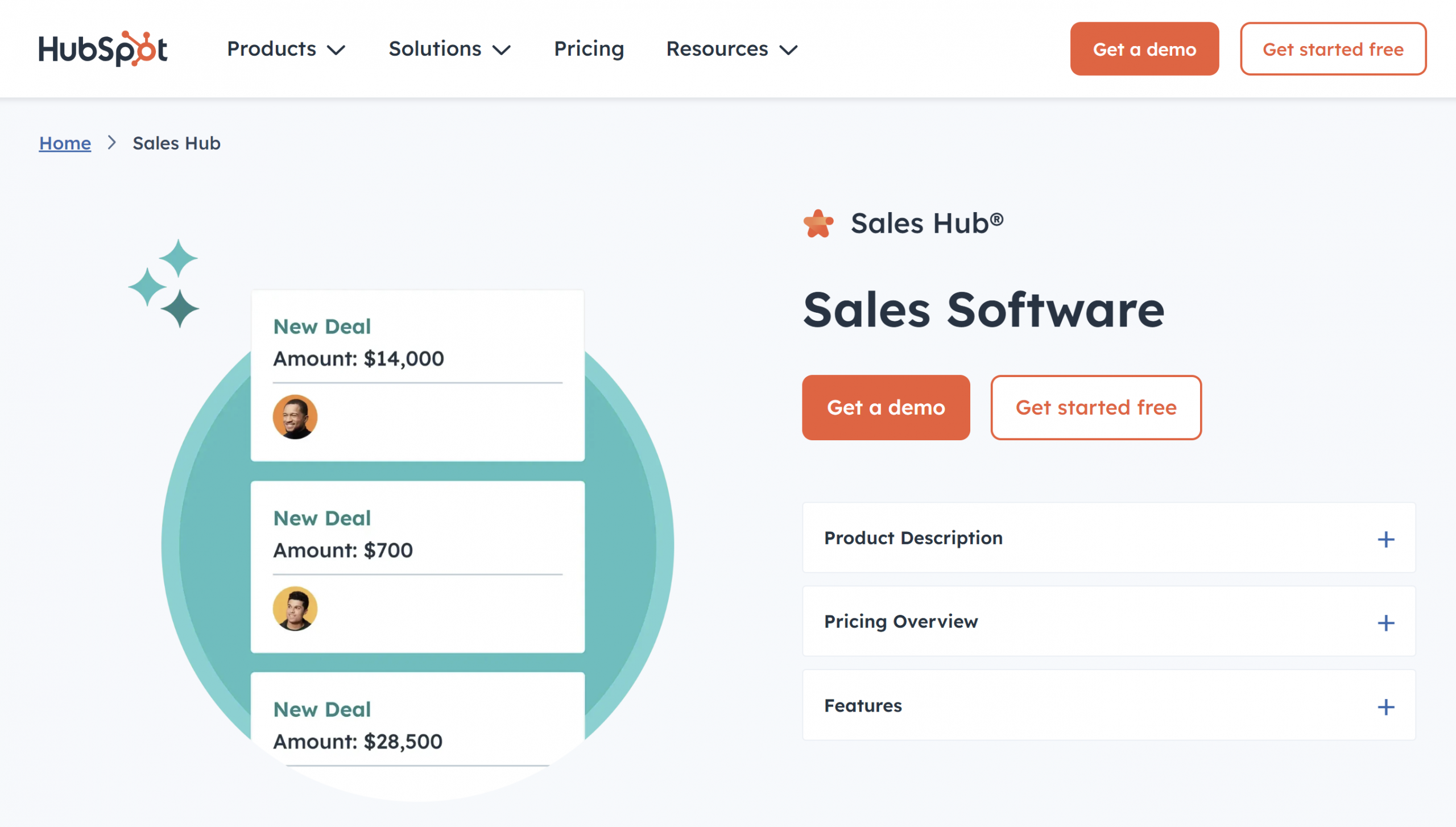
Here are some of the top features and benefits:
- All-in-one customer relationship management (CRM) platform that combines contact management, website tracking, and pipeline management so you have a complete view of each customer’s journey.
- Sales enablement tools like email tracking, task management, and quote creation to keep reps focused and on track.
- Marketing automation to handle email marketing, social media, and ad tracking, making it easier to keep prospects engaged.
- Advanced analytics and reporting to help you understand team performance and make data-driven adjustments.
Pricing
Plans start at $15/month for access to HubSpot’s essential marketing, sales, service, content, and operations software.
Gong
Gong gives you a clear view of what’s happening in your sales calls and meetings.
You can spot what works, coach your team well, and keep deals on track by capturing and analyzing conversations. If you want a smarter approach to sales, Gong is a solid choice.
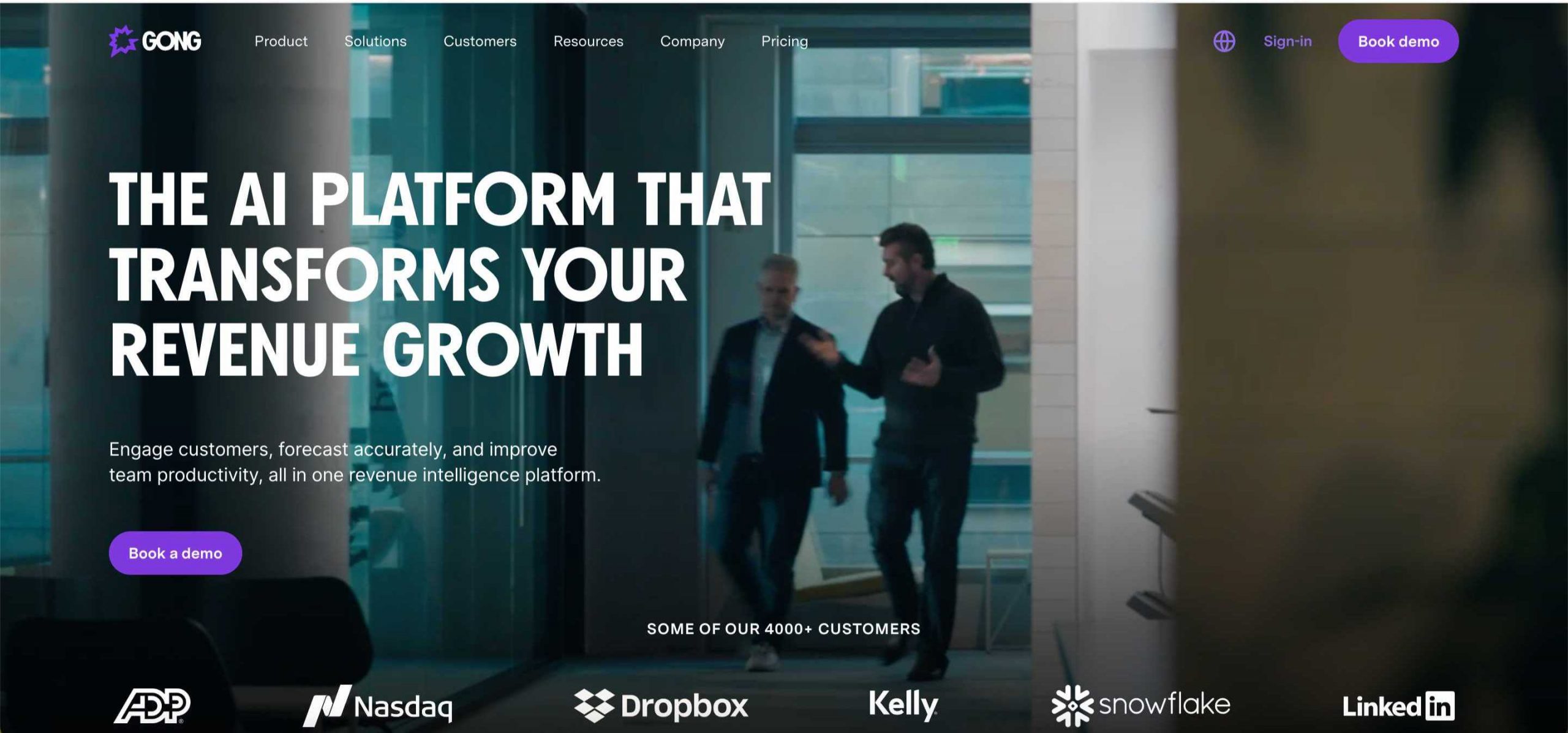
Here are some of the top features and benefits that help boost sales productivity:
- Conversation intelligence that automatically records and analyzes sales calls, helping you see what works and what doesn’t.
- Deal intelligence tracks deal progress in real-time, flagging any issues so your team can act fast.
- Coaching tools that make it easier for managers to give targeted, constructive feedback based on actual sales conversations.
- AI-powered analytics that break down call topics, customer sentiment, and engagement trends, giving your team a deeper understanding of each interaction.
Pricing
Gong’s pricing isn’t public. With a little research, you can find that Gong costs $1,500 per sales rep per year.
Lemlist
Lemlist lets you send personalized email campaigns that feel authentic, not automated. It’s perfect for teams looking to add a personal touch to their outreach without the extra effort.
With Lemlist, you can connect with prospects in a way that stands out and keep follow-ups on autopilot.
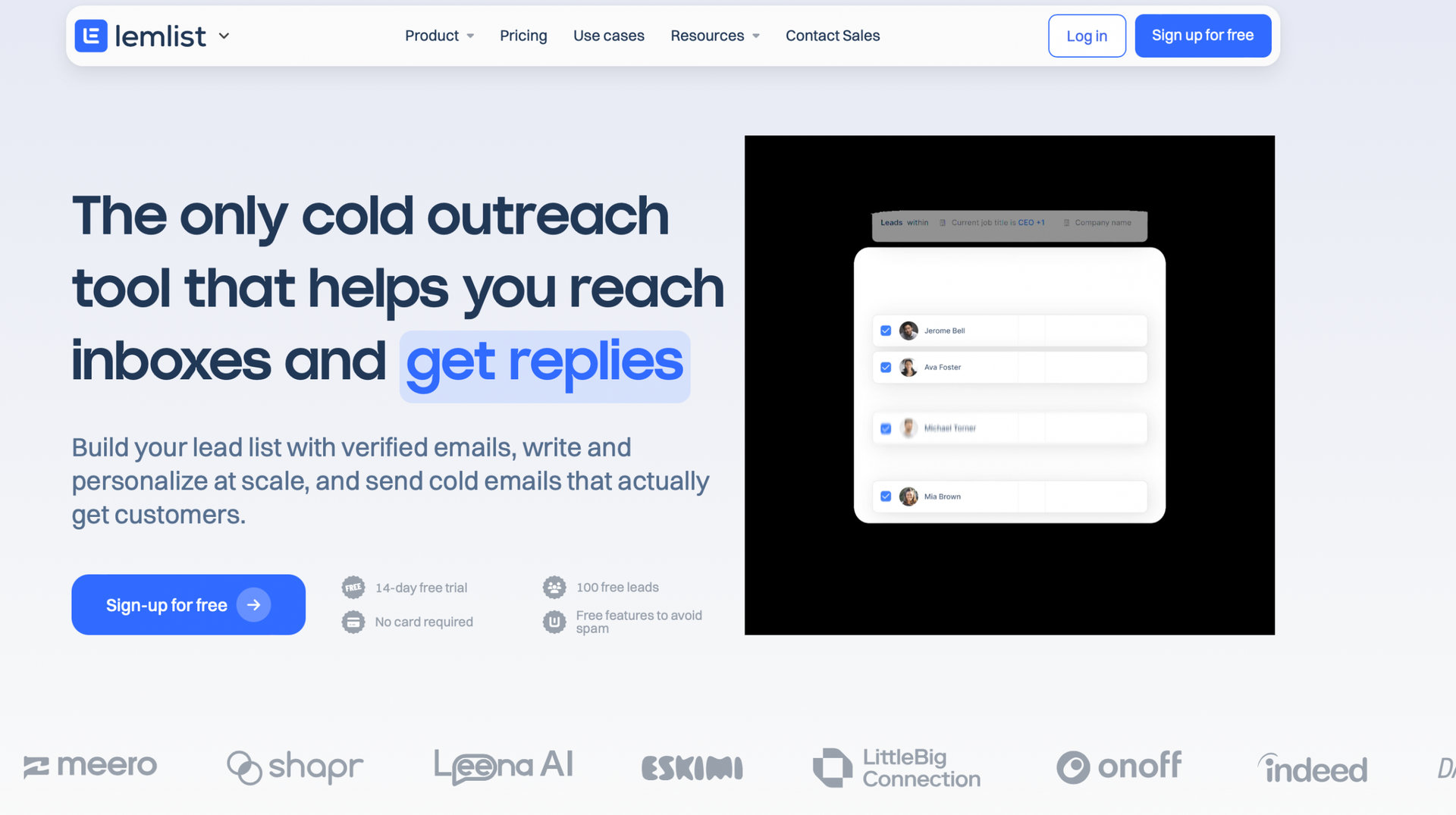
Here are some of the top features and benefits:
- Personalized email campaigns with options for custom images and dynamic content to make each email feel unique.
- Automated follow-ups that keep leads engaged without manual tracking so that you can focus on active conversations.
- Multi-channel outreach that combines email, LinkedIn, and phone for a coordinated approach to connecting with prospects.
- Performance analytics that give you insight into open rates, reply rates, and more so you can continuously improve your sales strategies.
Pricing
Pricing starts at $39/user/month, including unlimited campaigns, customizable email templates, an email finder verifier (750 credits/month), and access to a 450M+ leads database.
Conclusion
When it comes to improving sales productivity, you must focus on the right actions and use the right tools.
Use strategies like intent-based prospecting, automated lead enrichment, and personalized messaging to work smarter, close deals faster, and make more money.
Try PhantomBuster’s 14-day free trial to see how automation and AI can improve your sales performance!
